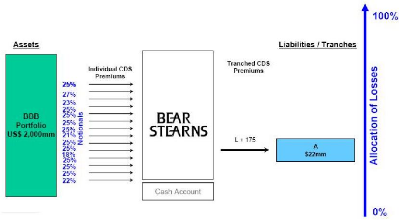Collateralized Synthetic Obligations (CSO) are securities
issued by a Special Purpose Vehicle (SPV) and backed by a portfolio of credit
protection-selling positions taken through several (usually over 100) CDS. The
liabilities of the SPV get sliced into several CSO tranches that get hit
sequentially in case one or more reference entities within the underlying CDS
portfolio default. As a result, the fair premium of any tranche, usually
expressed as a spread over 3-month LIBOR/EURIBOR rate, eventually depends on
the joint-loss distribution of the underlying CDS portfolio.
CSO tranches can be defined by their attachment and detachment
points:
· The attachment point l of the tranche is expressed as
a percentage of the investment notional. It is the portfolio loss lower
threshold above which the tranche's principal gets hit if one or several
reference entities default within the portfolio.
· The detachment point u > l of the tranche is
expressed as a percentage of the investment notional. It is the portfolio loss
upper threshold above which the tranche's principal gets wiped out after one or
several events of default.
CSO tranches are labelled upon their seniority in the capital
structure:
· The equity tranche has the lowest attachment point
of the structure - 0% - and usually a detachment point below 3%. Hence it is
the riskiest tranche of the structure.
· The super senior tranche has the highest attachment point
of the structure - usually around 22% - and a detachment point of 100%.
· Mezzanine tranches have an attachment point above the
equity's detachment point and a detachment point below the senior's attachment
point.
· Senior tranches have an attachment point above the
mezzanine's detachment point and a detachment point below the supersenior's
attachment point.
Unlike cash Collateralized Debt Obligations (CDO), CSOs are
not backed by a portfolio of physical bonds or loans but by a portfolio of CDS
contracts. This latter feature allows much more flexibility in structuring
tailor-made securities than cash-based CDOs:
· Physical bonds or loans only exist in limited quantity,
whereas CDS contracts
can be created as long as two counterparties agree to
trade with each other;
· Whenever a cash-CDO is structured, all tranches must
be sold to the investors, i.e. the deal must be fully syndicated, unless the
CDO-arranging bank wants to keep some risk in it books, whereas CSO tranches
can be structured independently because their payoffs can be replicated through
model-based offsetting CDS positions.
· Transaction follow-up duties are heavier for cash-CDOs
than for CSOs: for instance, loans can be subject to contingent early
repayments.

Figure 1.2: Structuring of a single-tranch CSO
CSO tranches on credit indices
As mentioned earlier, the price of a CSO tranche, which is
defined by its attachment and detachment points within the capital structure,
is a function of the joint-loss distribution of an underlying reference CDS
portfolio. This joint-loss distribution function can be modeled in terms of two
sets of parametres:
· single-name CDS spreads can be seen as proxies for
valuing the default risk of each reference entity;
· cross-asset default risk dependency parametres, i.e.
«correlation», that aim at describing the joint default-behaviour of
a portfolio of reference entities.
The rationale for setting up a liquid market for tranches
with standardized characteristics (attachment and detachment points) and
referencing standard CDS portfolios (typically ITRAXX IG or
CDX.NA.IG for 3,5,7 and 10 year-maturities)
was to make correlation tradable, thereby allowing flexible correlation hedging
for structured credit products.
Given that this market for standardized CSO tranches on
credit indices aims at pricing correlation only and not default risk on any
single name, tranches are quoted in terms of credit spread (measrued in basis
points) on a Delta-Exchange basis: in other words, tranches and offsetting CDS
positions are traded at the same time so that the resulting exposure of the
investor is only to correlation and not to single-name first-order spread risk.
Unlike other tranches which are quoted as a full running spread, the equity
tranche (0%-3%), which is the riskiest slice of the capital structure, is
quoted on a running basis assuming the protection seller on this tranche
receives a 5% upfront premium.
Bespoke Collateralized Synthetic Obligations
Bespoke CSOs are tailor-made versions of CSO tranches on
credit indices: the underlying CDS portfolio can be customized, as well as the
characteristics of the tranche. This range of products offers more flexibility
than standard tranches, for it allows the investor to choose his own credit
risk profile by playing with the shape of the joint-loss distribution function
(bespoke CDS portfolio) and choosing the attachment/detachment points that suit
his aversion to risk.
In addition to tailoring the initial underlying CDS portfolio
to the investor's needs, investment banks usually propose managed versions of
bespoke CSOs that allow the underlying CDS portfolio to be revised later on in
the transaction's life: the arranging bank appoints an external credit risk
manager whose role is to manage actively the underlying CDS portfolio by making
substitutions and weight adjustments among referenced single names.
Options on credit indices and tranches
As the liquidity of credit indices keeps improving, bid-offer
spreads decrease and investment banks start proposing swaptions on major credit
indices (ITRAXX XOVER, ITRAXX IG, CDX NA IG,...) on standard maturities (roll
dates, i.e. 20-Mar, 20- Jun, 20-Sep, 20-Dec) and tenors (3Y,5Y,7Y).



